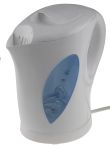Kettles
A kettle is a simple device used to boil water and consists of a container to hold the water, a spout for pouring, a handle and a lid. They are also referred to as a teakettle or jug kettle.The main compartment contains a heating element which is often referred to as a coil. When the kettle is switched on, an electric current flows through the heating element turning the electrical resistance into electrical energy and warming the cold water inside.The heat produced by the heating element brings the water to boiling point at which point the kettle is switched off, usually in response to a thermostat once the required temperature is reached.FeaturesCordless electric kettles consist of a base unit and the main unit. The base unit is connected to the mains by a power cord.Rapid boil enables more water to be boiled in a shorter amount of time compared to a kettle which does not have the rapid boil feature.The water level indicator shows the capacity in litres and makes the amount of water more visible, plus you can also see how fast it is boiling. There are also see-through glass kettles which have excellent visibility of the boiling water.Boil-dry protection is a feature that allows the kettle to switch off once there is no more water.Stainless steel conducts heat much better than plastic so is often a common choice for kitchen appliances.Limescale filters make hard water softer before it is boiled extending the life of heating element.Variable temperature control is a useful feature to have when making different types of speciality tea.ApplicationsKettles are extremely useful and are found in almost every kitchen around the world. So no matter whether you are a coffee drinker or need to make a cuppa, having a kettle definitely comes in handy.To make electric kettles more energy efficient, only fill with as much water as required, switch off at the wall when not in use and clean often to reduce limescale build-up.De-scalingLimescale is calcium carbonate which is present in water (especially hard water) and deposited when hot water evaporates. Scale prevention chemicals can be used for cleaning, alternatively natural cleaners like vinegar or lemon juice can be used.



